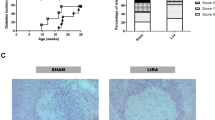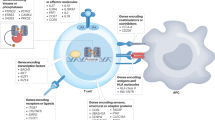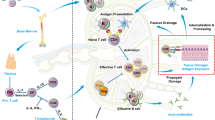Abstract
Animal models and human studies have provided strong evidence that the immune response that causes type 1A diabetes is initiated against a limited array of antigens but acquires breadth and depth until β-cell mass has been critically compromised. Two recent trials confirmed the ability to identify relatives at risk for development of diabetes, but were unsuccessful in preventing disease. Treatment of at-risk individuals with oral insulin, which is postulated to be an antigen in the disease, did however show efficacy in a subgroup of these subjects, suggesting that antigen-specific prevention approaches might be successful in the right group of subjects at the right time. Earlier trials showed that the natural progression of disease can be altered with conventional immune suppression but these approaches have been supplanted by tolerance-induction strategies. Anti-CD3 monoclonal antibodies have shown efficacy in preventing the loss of insulin production over the first 2 years of disease without chronic immune suppression. The mechanisms are novel, and appear to involve induction of immune regulation by the monoclonal antibody. Ultimately, preservation and even improvement in β-cell mass is the goal of therapy. The means needed to achieve this will depend on the timing and mechanisms of the immune intervention and might require combinations of agents.
Key Points
-
Type 1A diabetes mellitus results form the progressive and specific autoimmune destruction of insulin-secreting pancreatic β cells; the disease develops over a period of years and continues after initial clinical presentation
-
The ultimate goal of therapeutic interventions is preservation (and even increase) of β-cell mass; the level of endogenous β-cell function is related to the ease and stability of metabolic control
-
Identification of suitable candidates for therapy, appropriate timing and specificity of intervention are critical for successful intervention; high-risk relatives of patients with type 1 diabetes can be identified using a combination of metabolic and immunologic measurements
-
New approaches for immune therapy such as anti-CD3 antibodies have shown success in modulating the natural history of the disease without the need for chronic immune suppression; in the future, to cause lasting remission of disease, it is likely that combinatorial approaches will be needed
This is a preview of subscription content, access via your institution
Access options
Subscribe to this journal
Receive 12 print issues and online access
$189.00 per year
only $15.75 per issue
Buy this article
- Purchase on SpringerLink
- Instant access to full article PDF
Prices may be subject to local taxes which are calculated during checkout

Similar content being viewed by others
References
Gianani R and Eisenbarth GS (2005) The stages of type 1A diabetes: 2005. Immunol Rev 204: 232–249
Steele C et al. (2004) Insulin secretion in type 1 diabetes. Diabetes 53: 426–433
Gepts W (1965) Pathologic anatomy of the pancreas in juvenile diabetes mellitus. Diabetes 14: 619–633
Keymeulen B et al. (2005) Insulin needs after CD3-antibody therapy in new-onset type 1 diabetes. N Engl J Med 352: 2598–2608
Teuscher AU et al. (1998) Successful islet autotransplantation in humans: functional insulin secretory reserve as an estimate of surviving islet cell mass. Diabetes 47: 324–330
Chase HP et al. (2004) Redefining the clinical remission period in children with type 1 diabetes. Pediatr Diabetes 5: 16–19
Strandell E et al. (1990) Reversal of β-cell suppression in vitro in pancreatic islets isolated from nonobese diabetic mice during the phase preceding insulin-dependent diabetes mellitus. J Clin Invest 85: 1944–1950
Sempe P et al. (1991) Anti-α/β T cell receptor monoclonal antibody provides an efficient therapy for autoimmune diabetes in nonobese diabetic (NOD) mice. Eur J Immunol 21: 1163–1169
Palmer JP et al. (2004) C-peptide is the appropriate outcome measure for type 1 diabetes clinical trials to preserve β-cell function: report of an ADA workshop, 21-22 October 2001. Diabetes 53: 250–264
Robey E and Fowlkes BJ (1994) Selective events in T cell development. Annu Rev Immunol 12: 675–705
Arif S et al. (2004) Autoreactive T cell responses show proinflammatory polarization in diabetes but a regulatory phenotype in health. J Clin Invest 113: 451–463
Rossini AA (2004) Autoimmune diabetes and the circle of tolerance. Diabetes 53: 267–275
Roncarolo MG et al. (2001) Type 1 T regulatory cells. Immunol Rev 182: 68–79
Bach JF and Chatenoud L (2001) Tolerance to islet autoantigens in type 1 diabetes. Annu Rev Immunol 19: 131–161
Bluestone JA and Abbas AK (2003) Natural versus adaptive regulatory T cells. Nat Rev Immunol 3: 253–257
Rabinovitch A (1998) An update on cytokines in the pathogenesis of insulin-dependent diabetes mellitus. Diabetes Metab Rev 14: 129–151
Katz JD et al. (1995) T helper cell subsets in insulin-dependent diabetes. Science 268: 1185–1188
Herold KC (2004) Achieving antigen-specific immune regulation. J Clin Invest 113: 346–349
Saoudi A et al. (1996) The thymus contains a high frequency of cells that prevent autoimmune diabetes on transfer into prediabetic recipients. J Exp Med 184: 2393–2398
Salomon B et al. (2000) B7/CD28 costimulation is essential for the homeostasis of the CD4+CD25+ immunoregulatory T cells that control autoimmune diabetes. Immunity 12: 431–440
Shevach EM (2000) Regulatory T cells in autoimmmunity. Annu Rev Immunol 18: 423–449
Walker MR et al. (2003) Induction of FoxP3 and acquisition of T regulatory activity by stimulated human CD4+CD25− T cells. J Clin Invest 112: 1437–1443
Apostolou I and von Boehmer H (2004) In vivo instruction of suppressor commitment in naive T cells. J Exp Med 199: 1401–1408
Brusko TM et al. (2005) Functional defects and the influence of age on the frequency of CD4+CD25+ T-cells in type 1 diabetes. Diabetes 54: 1407–1414
Green AE et al. (2003) CD4+CD25+ T regulatory cells control anti-islet CD8+ T cells through TGF-β-TGF-β receptor interactions in type 1 diabetes. Proc Natl Acad Sci USA 100: 10878–10883
Gorus FK et al. (1997) IA-2-autoantibodies complement GAD65-autoantibodies in new-onset IDDM patients and help predict impending diabetes in their siblings. The Belgian Diabetes Registry. Diabetologia 40: 95–99
Lieberman SM et al. (2003) Identification of the β cell antigen targeted by a prevalent population of pathogenic CD8+ T cells in autoimmune diabetes. Proc Natl Acad Sci USA 100: 8384–8388
Jones DB et al. (1990) Heat-shock protein 65 as a β cell antigen of insulin-dependent diabetes. Lancet 336: 583–585
Kent SC et al. (2005) Expanded T cells from pancreatic lymph nodes of type 1 diabetic subjects recognize an insulin epitope. Nature 435: 224–228
Nakayama M et al. (2005) Prime role for an insulin epitope in the development of type 1 diabetes in NOD mice. Nature 435: 220–223
Sercarz EE (2000) Driver clones and determinant spreading. J Autoimmun 14: 275–277
Yu L et al. (1996) Anti-islet autoantibodies usually develop sequentially rather than simultaneously. J Clin Endocrinol Metab 81: 4264–4267
Diabetes Prevention Trial—Type 1 Diabetes Study Group (2002) Effects of insulin in relatives of patients with type 1 diabetes mellitus. N Engl J Med 346: 1685–1691
Skyler JS et al. (2005) Effects of oral insulin in relatives of patients with type 1 diabetes: The Diabetes Prevention Trial—Type 1. Diabetes Care 28: 1068–1076
Mandrup-Poulsen T et al. (1993) Nicotinamide treatment in the prevention of insulin-dependent diabetes mellitus. Diabetes Metab Rev 9: 295–309
Gale EA et al. (2004) European Nicotinamide Diabetes Intervention Trial (ENDIT): a randomised controlled trial of intervention before the onset of type 1 diabetes. Lancet 363: 925–931
Shoda LK et al. (2005) A comprehensive review of interventions in the NOD mouse and implications for translation. Immunity 23: 115–126
Gale EA (2003) Intervening before the onset of type 1 diabetes: baseline data from the European Nicotinamide Diabetes Intervention Trial (ENDIT). Diabetologia 46: 339–346
Hagopian WA et al. (1995) Glutamate decarboxylase-, insulin-, and islet cell-antibodies and HLA typing to detect diabetes in a general population-based study of Swedish children. J Clin Invest 95: 1505–1511
Riley WJ et al. (1990) A prospective study of the development of diabetes in relatives of patients with insulin-dependent diabetes. N Engl J Med 323: 1167–1172
Hummel M et al. (2004) Psychological impact of childhood islet autoantibody testing in families participating in the BABYDIAB study. Diabet Med 21: 324–328
Johnson SB et al. (1990) Psychological impact of islet cell-antibody screening. Preliminary results. Diabetes Care 13: 93–97
Bougneres PF et al. (1988) Factors associated with early remission of type I diabetes in children treated with cyclosporine. N Engl J Med 318: 663–670
Stiller CR et al. (1984) Effects of cyclosporine immunosuppression in insulin-dependent diabetes mellitus of recent onset. Science 223: 1362–1367
Silverstein J et al. (1988) Immunosuppression with azathioprine and prednisone in recent-onset insulin-dependent diabetes mellitus. N Engl J Med 319: 599–604
Eisenbarth GS et al. (1985) Anti-thymocyte globulin and prednisone immunotherapy of recent onset type 1 diabetes mellitus. Diabetes Res 2: 271–276
Harrison LC et al. (1985) Increase in remission rate in newly diagnosed type I diabetic subjects treated with azathioprine. Diabetes 34: 1306–1308
Bougneres PF et al. (1990) Limited duration of remission of insulin dependency in children with recent overt type I diabetes treated with low-dose cyclosporin. Diabetes 39: 1264–1272
Parving HH et al. (1999) Cyclosporine nephrotoxicity in type 1 diabetic patients. A 7-year follow-up study. Diabetes Care 22: 478–483
Maki T et al. (1992) Long-term abrogation of autoimmune diabetes in nonobese diabetic mice by immunotherapy with anti-lymphocyte serum. Proc Natl Acad Sci USA 89: 3434–3438
Harrison LC et al. (2004) Pancreatic β-cell function and immune responses to insulin after administration of intranasal insulin to humans at risk for type 1 diabetes. Diabetes Care 27: 2348–2355
Kaufman DL et al. (1993) Spontaneous loss of T-cell tolerance to glutamic acid decarboxylase in murine insulin-dependent diabetes. Nature 366: 69–72
Tisch R et al. (1993) Immune response to glutamic acid decarboxylase correlates with insulitis in non-obese diabetic mice. Nature 366: 72–75
Tian J et al. (1996) Nasal administration of glutamate decarboxylase (GAD65) peptides induces TH2 responses and prevents murine insulin-dependent diabetes. J Exp Med 183: 1561–1567
Tian J et al. (1996) Modulating autoimmune responses to GAD inhibits disease progression and prolongs islet graft survival in diabetes-prone mice. Nat Med 2: 1348–1353
Agardh CD et al. (2005) Clinical evidence for the safety of GAD65 immunomodulation in adult-onset autoimmune diabetes. J Diabetes Complications 19: 238–246
Brudzynski K et al. (1992) Secretory granule autoantigen in insulin-dependent diabetes mellitus is related to 62 kDa heat-shock protein (hsp60). J Autoimmun 5: 453–463
Elias D et al. (1991) Vaccination against autoimmune mouse diabetes with a T-cell epitope of the human 65-kDa heat shock protein. Proc Natl Acad Sci USA 88: 3088–3091
Raz I et al. (2001) β-cell function in new-onset type 1 diabetes and immunomodulation with a heat-shock protein peptide (DiaPep277): a randomised, double-blind, phase II trial. Lancet 358: 1749–1753
Zanin-Zhorov A et al. (2005) Heat shock protein 60 inhibits TH1-mediated hepatitis model via innate regulation of TH1/TH2 transcription factors and cytokines. J Immunol 174: 3227–3236
Chatenoud L et al. (1997) CD3 antibody-induced dominant self tolerance in overtly diabetic NOD mice. J Immunol 158: 2947–2954
Chatenoud L et al. (1994) Anti-CD3 antibody induces long-term remission of overt autoimmunity in nonobese diabetic mice. Proc Natl Acad Sci USA 91: 123–127
Herold KC et al. (2003) Activation of human T cells by FcR nonbinding anti-CD3 mAb, hOKT3γ1(Ala–Ala). J Clin Invest 111: 409–418
Xu D et al. (2000) In vitro characterization of five humanized OKT3 effector function variant antibodies Cell Immunol 200: 16–26
Herold KC et al. (2002) Anti-CD3 monoclonal antibody in new-onset type 1 diabetes mellitus. N Engl J Med 346: 1692–1698
Herold KC et al. (2005) A single course of anti-CD3 monoclonal antibody hOKT3γ1(Ala–Ala) results in improvement in C-peptide responses and clinical parameters for at least 2 years after onset of type 1 diabetes. Diabetes 54: 1763–1769
Chatenoud L et al. (2001) Suppressor T cells—they're back and critical for regulation of autoimmunity! Immunol Rev 182: 149–163
Belghith M et al. (2003) TGF-β-dependent mechanisms mediate restoration of self-tolerance induced by antibodies to CD3 in overt autoimmune diabetes. Nat Med 9: 1202–1208
Bisikirska B et al. (2005) TCR stimulation with modified anti-CD3 mAb expands CD8 T cell population and induces CD8+CD25+ Tregs . J Clin Invest 115: 2904–2913
Bonner-Weir S (2000) Perspective: postnatal pancreatic β cell growth. Endocrinology 141: 1926–1929
Xu G et al. (1999) Exendin-4 stimulates both β-cell replication and neogenesis, resulting in increased β-cell mass and improved glucose tolerance in diabetic rats. Diabetes 48: 2270–2276
Garcia-Ocana A et al. (2000) Hepatocyte growth factor overexpression in the islet of transgenic mice increases β cell proliferation, enhances islet mass, and induces mild hypoglycemia. J Biol Chem 275: 1226–1232
Service GJ et al. (2005) Hyperinsulinemic hypoglycemia with nesidioblastosis after gastric-bypass surgery. N Engl J Med 353: 249–254
Cummings DE (2005) Gastric bypass and nesidioblastosis—too much of a good thing for islets? New Eng J Med 353: 300–302
Li Y et al. (2003) Glucagon-like peptide-1 receptor signaling modulates β cell apoptosis. J Biol Chem 278: 471–478
Ogawa N et al. (2004) Cure of overt diabetes in NOD mice by transient treatment with anti-lymphocyte serum and exendin-4. Diabetes 53: 1700–1705
Daneman D and Clarson C (1987) Residual β-cell function in children with type 1 diabetes: measurement and impact on glycemic control. Clin Invest Med 10: 484–487
Clarson C et al. (1987) Residual β-cell function in children with IDDM: reproducibility of testing and factors influencing insulin secretory reserve. Diabetes Care 10: 33–38
The Diabetes Control and Complications Trial Research Group (1998) Effect of intensive therapy on residual β-cell function in patients with type 1 diabetes in the diabetes control and complications trial. A randomized, controlled trial. Ann Intern Med 128: 517–523
Steffes MW et al. (2003) β-cell function and the development of diabetes-related complications in the diabetes control and complications trial. Diabetes Care 26: 832–836
Eisenbarth G (1986) Type I diabetes mellitus. A chronic autoimmune disease. New Eng J Med 314: 1360–1368
Eisenbarth G (1984) Autoimmune β cell insufficiency—diabetes mellitus type 1. Triangle 23: 111–124
Acknowledgements
Supported by National Institutes of Health grants DK57846, AI98-010, DK063608, RR00645, and DK063608.
Author information
Authors and Affiliations
Corresponding author
Ethics declarations
Competing interests
The authors declare no competing financial interests.
Rights and permissions
About this article
Cite this article
Cernea, S., Herold, K. Drug Insight: new immunomodulatory therapies in type 1 diabetes. Nat Rev Endocrinol 2, 89–98 (2006). https://doi.org/10.1038/ncpendmet0082
Received:
Accepted:
Issue date:
DOI: https://doi.org/10.1038/ncpendmet0082
This article is cited by
-
Pancreatic duodenal homeobox 1 protein is a novel β-cell-specific autoantigen for type I diabetes
Laboratory Investigation (2010)



